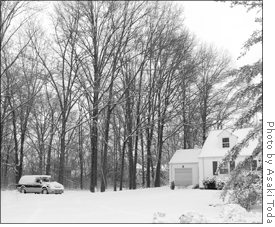
| << Front page | News | March 7, 2008 |
College Plans to Pave Paradise and Build New Parking Lot
 |
|
| Open Fields No More This lot on North Professor Street is the future site of a paved lot for student parking. | |
Just past Stevenson, on North Professor Street, sits a spacious wooded area. Although its trees are bare and covered in snow right now, it won’t be long until the area is leafy and green again, vibrant with suburban wildlife and foliage. This space, however, may not last until warmer spring weather. The College has definite plans to construct two parking lots, one in this area and another on West College Street that will connect to the existing lot by the Adam Joseph Lewis Center. The estimated cost for these projects will be one million dollars, according to Vice President for Finance Ron Watts.
A parking committee formed several years ago to address the issue of student parking, and one of the decisions made was that all new construction of student housing had to have one parking space for every two beds. Although building new parking lots does fit within the College’s plan to increase parking availability, environmental concerns have been raised.
For example, the site for the N. Professor lot currently boasts many plants and trees that would be destroyed in the development. There are also a number of animals living there, including white squirrels, chipmunks, deer, groundhogs and birds. This final location is different from the originally proposed area, which included unique flora and fauna, such as two butternut trees.
Construction of a new parking lot was first proposed about three years ago in conjunction with plans to build another campus dormitory. Both projects are expected to go through, but the dormitory is being reconsidered with a new design to be presented in the next Board of Trustees meeting.
In December 2007, the College presented its plan for review to the Oberlin Planning Commission. Plans were “approved by a vote of 3 to 2…with minor changes [to aid accessibility],” said Chair of the Planning Commission Marilyn Fedelchak.
“Parking is probably the biggest concern, always,” said Fedelchak. “Too many students park downtown; they park on neighborhood streets.”
Some feel that the environmental concerns involved outweigh the parking woes. “I am sympathetic to the College’s difficult circumstance, [but] I’m not an enthusiast for parking lots, and I’m not enthused for having trees and natural habitats torn down,” said City Council President David Sonner.
While there are no city laws or regulations that require the College to provide a certain amount of parking for its students, many student cars often fill the downtown area, making it harder for customers to park there. In addition, a heavy volume of street parking can be a safety hazard.
Residents of the town recognize the need for more student parking on campus in order to alleviate congestion problems on Oberlin streets, but many also feel that the decision was too rushed.
“The College really bypassed any community involvement,” said Kate Pilacky, an Oberlin resident who has lived near the area where the lot will be built for about nine years. “I’d like there to be more discussion. That’s all I’m asking for.” Pilacky is also the associate field director of the Firelands chapter of the Western Reserve Land Conservancy.
Associate Professor of Harpsichord Webb Wiggins lives on N. Professor in a College-owned house that stands to the immediate right of the wooded area. He was unaware of the College’s plans to construct a parking lot until he returned home one morning to find two trucks in his driveway.
“One truck was pulling out, but one truck was still running,” said Wiggins. “[The driver] waved me down. I had to turn back around.” Wiggins learned of the College’s plans after a brief conversation with the driver, who was a subcontractor in charge of “removing all the trees and clearing the lot.”
“We have to preserve white squirrels,” he said, referring to Oberlin’s signature “albino” squirrels.
The College is also aware of environmental concerns.
“In an effort to be sensitive to the surrounding environment, landscaping, buffering, screening and cut-off lighting will be included in the construction of new parking areas,” said Executive Director of College Relations Rick Sherlock.
Sustainability Coordinator Nathan Engstrom also mentioned other options, such as permeable paving, which would allow water to drain back into the ground. Something as simple as gravel could suffice.
In conjunction with increased parking, the College is looking for ways to reduce the number of student cars. This may be difficult to do, as new construction projects such as the Conservatory’s new Jazz Studies building require parking lots.
“The College makes its best effort to educate students on the issue and to discourage students from bringing cars to a campus with bicycle-friendly policies and adequate bike storage,” said Sherlock. He mentioned a letter that is sent from the dean of students to incoming first-years “[that] details the advantages and disadvantages of bringing a car to campus.”
This is a solution with which Sonner can agree. He said that “the automobile is one of the most destructive instruments ever devised,” in terms of endangering the environment.
The College is currently working to compose a response to members of the community who have expressed their concerns.
About us
Subscriptions
Advertising